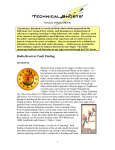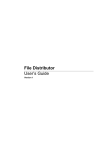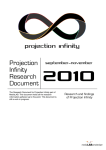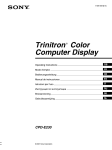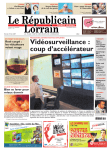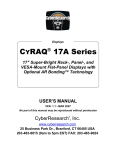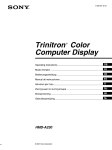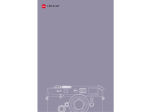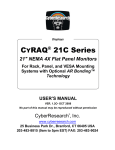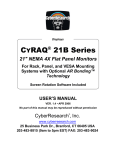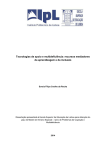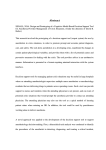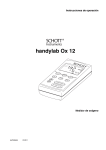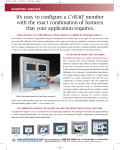Download Ifra1 sp ecial Report 2.23 - WAN-IFRA
Transcript
Ifra1 sp ecial Report 2.23 Soft proofing of full newspaper pages L x Materials (1) Pre-Press (2) Press (3) Mailroom and Distribution (4) Electronic Communication (5) General (6) This graphic shows the smull size of a newspuper printing colour gamut compared Mith nn RGB colour gamut, both displayed within the CIE colour Hard copy colour proofing has never been very popular with newspaper printers. It is time and cost consuming. And in many cases the proof results are hardly comparable to the final print. As the entire prepress workflow is now definitely on the way to full digitisation and automation there is almost no more slot left for the chance of hard copy proofing. This is why IFRA looked into the possibilities of soft proofing of newspaper pages prior to full page output, either computer to film or to plate. What are the criteria a soft proofing system &n- newspaper production has to fulfill? Which monitors should be used? How does calibration work, and how is colour management involved? Which data formats and which inpu; devices are supported? How is the soft proofing workflow arranged? This report compares those requirem:nts to the specifications of available systems on the market. Practical expeqences of users from different countries conclude this Special Report. A detajled evaluation check list is also attached. With this report we want to assist those cjf our members who look for a fast and reliable soft proofing system. May 1997 Andy Williams Research Engineer/Repro IFRA .Wa\hingtonplat~ D-642X7 Danmtadt. Manfred Werfel Research Manager Tel +49 (614 I) 733-6. Fax +49 (6151) 733.800 Table of contents Introduction 2. 3. The use of monitor proofing in newspgpers ....................................................... 6 Evaluation criteria for a monitor proofing system ............................................ 7 3.1 3.1.1 3.1.2 3.2 3.3 3.3.1 3.4 3.5 3.5.1 3.5.2 3.5.3 3.5.4 3.6 3.6.1 3.6.2 3.6.3 3.6.4 3.6.5 3.6.6 3.6.7 3.6.8 3.7 3.8 3.9 Monitor .................................................................................................................... Technical properties ................................................................................................ Proofing properties .................................................................................................. Stabilisation, calibration and characterisation procedures .... ................................. Colour matching methods used by the system ....................................................... Matching the colour spaces of monitor and print ................................................... Viewing conditions ................................................................................................. Page description formats accepted as input ............................................................ PostScript ................................................................................................................ Portable Document Format ..................................................................................... TIFF/IT .................................................................................................................... Other formats .......................................................................................................... Input devices of final pages to the system .............................................................. Imagesetter .............................................................................................................. PostScript ................................................................................................................ Facsimile equipment ............................................................................................... Film/plate scanner ................................................................................................... Web inspection cameras .......................................................................................... Colour space of input device ................................................................................... Resolution delivered by input device ..................................................................... Other information delivered .................................................................................... Workflow and working practices ............................................................................ Page visualising software ........................................................................................ Usability .................................................................................................................. 4. 4.1 4.2 Testing criteria for a monitor proofing system ...1:.,............................................ 17 5. 5.1 5.2 0 IFRA, Darmstadt ........................................................................................................... 5 1. 7 7 8 11 12 12 13 13 13 13 14 14 14 14 14 14 14 15 15 15 15 15 15 16 Evaluation of the colour matching accuracy ......................................................... Visual assessment of col,our matching accuracy .................................................... 17 17 Short dgscription of existing systems ..................................................................... Evaluatbn of the systems ....................................................................................... 18 18 ‘, Evaluation of existing soft proofing systems ...................................................... 18 Practic&l experiences and advices ....................................................................... 22 6. 6.1 6.2 6.3 6.4 The Heliingin Sanomat Forssa printing plant - Pagevision ................................... Aftonbladet - Pagevision ........................................................................................ Los Angeles Times - ParaVisual ............................................................................ Berlingske Tidende - ParaVisual ........................................................................... 22 22 22 23 7. Conclusions ............................................................................................................ 23 8. References .............................................................................................................. 24 9. Appendix: Evaluation check list for soft proofing systems .............................. 26 1. Introduction Soft proofing of newspaper pages saves time, material and money, when compared to traditional photomechanical proofs and digital hard copies. It also enables a better management of the production process. For modern fullcolour newspapers physical proofing is not viable. For FM-screened pictures (FM = Frequency Modulated Screening) and computer-to-plate processes physical proofs are not feasible at all. It has been the scope of this study to specify the technical demands of a monitor proofing system for full pages. The study compares the demands to the technical specifications of soft proofing systems on the market and specifies the development of software needed to overcome the gaps. In order to offer useful information to the printer, the study identifies the places for monitor proofs in the newspaper reproduction chain. Moreover, the study presents a method of evaluating the performance of the monitor proof. The main application areas for soft proofing are production tracking, layout and colour accuracy inspection. The recommendations are as simple as possible taking these applications into account. In particular, the recommendations deal with the measuring and visual assessment of the colour matching accuracy. 0 IFRA, Darmstadt The researchers together with an expert working group have worked out the selection criteria. The study evaluates existing systems for soft proofing according to these criteria. Expert users have provided experiences of soft proofing systems. VTT Information Technology in Espoo, Finland, has carried out the research work as a commission of IFRA. The project leader was Prof. Caj Sodergard and the expert on image processing was Mr. Ari Siren, M.Sc., the project co-ordinator was Dr. Ulf Lindqvist. An expert working group with the following members conducted the project: Les Bovelandg, Scitex Europe, Waterloo, B Alain Bezy, Le Republicain Lorrain, Metz, F Aytun Erdentug, Parascan, Redwich, GB Boris Fuchs, IFRA, Darmstadt, D Sulo Nuutinen, Sanoma Corporation, Helsinki, FIN Ron Johnson, Aqua 4, Corporation, San Cleme.nte;USA Joel Maelfeyt, BARCO, Kortrijk, B Ilkka Ylakoski, Data Engineering, Helsinki, FIN Andy Williams, IFRA, Darmstadt, D Manfred Werfel, IFRA, Darmstadt, D, Moderator Ian Withers, Associated Media Base, London, GB 2. The use of monitor proofing in newspapers Monitor proofing is already in use to a certain degree in several production stages at newspapers (figure 1). Each production stage has its own requirements of the monitor proof. In this study, the focus has been on examining proofing solutions that visualise the digital page descriptions before or after the RIP as well as showing the content of the output film and plate. This kind of monitor proof provides the following benefits to the user, who most often is a technician, a press operator, but in some cases also an editor or an advertising -- agency._ Production stage to proof What is proofed? Proof Page element Colour match The proof shows the PostScript interpretation errors l shows page transmission errors like missing lines l shows colour separation mix-ups, mostly caused by misread ID codes from plates l offers the printing press operator a colour reference to stick to over the production run. The reference represents the “average” print-run. l allows the press operator to get himself familiar in advance with the work to be printed l is a communication vehicle between the page designer and the press operator l provides auxiliary functions like production tracking and ink presetting F l Who proofs? quality Full page Details Screen dots Size Layout grwhy X X X X Technician, Operator; Photographer 2. Ad design X X X X X 4. Page description or output on RIP X X 5. Output on film/plate X X 6. Printing X X . In-house High Designer, Ad agency In-house/ remote High X X X Technician, Editor, Ad agency Inhouse/ remote LOW X X X Technician, Pressman, Agencyeditor Inhouse/ remote High X X X Technician Inhouse/ remote Low/High Pressman X X X Figure 1. Monitor proofing in different production Resolution required Typo- 1. Scanner, Digital camera 3. Page make-up In-house or remote? Pressman Inhouse/ remote stages at a newspaper. The focus for this study is on stages 4 and 5. 0 IFRA, Darmstadt 3. Evaluation criteria for a monitor proofing system The potential buyer has to consider a set of criteria, when evaluating the feasibility of monitor proofing systems. The evaluation uses the documentation provided by the system vendors. The criteria are printed below as a checklist. Not all criteria might be applicable to a certain systern. A proofing system might come with several different monitors. In this case each monitor is separately evaluated. 3.1 Monitor 3.1.1 Technical properties Soft proofing technology is currently based on CRT-monitors, even if LCD displays with carefully designed filters promise a very good colour matching accuracy [GAT,96]. CRT-monitors work by aiming a beam of electrons at a blob of phosphor, which in turn glows. This glow is what we perceive as a pixel on the screen. A standard colour monitor has three dots (dot triad) at each location on the screen; red, green and blue (RGB). There is a corresponding electron gun for each colour that emits an electron beam of varying intensity - this corresponds to colour brightness. A generic display system consists of a computer, graphics display hardware and CRT-display (figure 2). The host computer manipulates the image values (pixels) and passes the digital pixel values to the frame buffer on the graphics board (= display controller). The D/A converters of the Video Signal Generator linearly transform the numerical pixel values in the frame buffer to video voltages. Standard voltage intervals exist for various applications. Typically they follow Electronic Industries Association (EIA) standards. Manually adjustable display settings include parameters like colour temperature, brightness, contrast, spatial properties, RGBgun voltage and convergence. The size of the monitor (vertically and horizontally) has an effect on the simulation of the printed page. Newspaper pages look different on small monitors. In practice, proofing a broadsheet page demands at least a 20 inch monitor. However, bigger monitors need a higher bandwidth compared to smaller monitors to maintain the frame refresh rates and to prevent flickering. One possibility to prevent flickering in the past was to select long persistence phosphors, Nowadays, vendors do not offer long persistence phosphors, because of small market needs and of technical weaknesses (short life time, low light output). The graphics board settings define spatial resolution (for example 1024 x 768 pixels). .The. settings should correspond to the monitor’s shadow masks and the resolution of the monitor. A high resolution (for example 1600 x 1200) leads to small fonts, if the physical monitor is not big enough. It may also lead to lower refresh rates and therefore to heavier flickering and lower visual quality. The shadow mask of the monitor affects the picture quality. It ensures that the electrons from each gun strike the corresponding phosphor. The three electron beams arrive at slightly different angles from the three separate electron guns. It is therefore possible to construct and align the shadow mask so that the electron beam from one gun will strike the correct phosphor dot, but the other two phosphors will be in shadow. In this way, the intensity of I- ComputerSystem Raster-Scan CRT VideoSig “r ’ “g ,” d Figure 2. A generic display system [Berm, 931. 0 IFRA, Darmstadt A. red,green,andbluesignalsVG , to controlgtids. B. beamcurrentfeedbackfromguncathodes. C. 2ndRGBgrids,focusscwens,anddeflectionyokes. D. cathodeheater. 7 red, green and blue is separately controlled at each dot triad location. The shadow mask is usually an INVAR mask (64% iron, 36% nickel) which is a thin plate with small holes punched in it. Only about 20-30% of the electron beam actually pass through the holes in the mask and hit the screen phosphor. The rest of the energy dissipates as heat from the mask. As a result, shadow mask monitors are prone to colour purity problems as they heat up due to slight shifts in the position of the holes relative to the phosphor dots. The Trinitron tubes have shadow masks with vertical slits instead of holes leading to a higher penetration of electrons and subsequently less heating. However, modern INVAR monitors come close to the Trinitrons in colour purity. Channel independence means that the RGB values do not affect each other. Constant phosphors keep their chromaticity when the excitation level of the phosphor changes and constant channels do not interfere with other channels. In practice, only dedicated fully stabilised monitors with independent RGB amplifiers have totally independent channels. Usually the red channel electronic beam strikes only red phosphors, but in some displays the red beam strikes also green or blue phosphors [Berns, 931. The same is true for the green and blue beams. Macro spatial independence of RGB pixels means that surrounding pixels do not affect the selected pixel intensities. Most commonly poor spatial independence is due to unstabilised power supply. An accuracy of 2.5 V over the 27 kV black-to-white interval guarantees good independence. Fortunately, the problem is easily detected by showing a test image on the screen with a white square (about 5 cm each side) in the middle of the screen, while the surrounding is black. Measuring this small square (for example in CIELAB) and comparing it with the same measurement, when the white page covers the whole screen, reveals monitors spatial independence. Monitors with poor spatial independence should not be used. Lowering the monitor luminance improves the spatial independence. However, this makes it difficult to compare soft proof with hard copy proofs and printed colour images, because the viewing illumination of a monitor is normally high [Berns, 931. Micro spatial independence is the absence of interaction between RGB signal channels and is even more essential than macro independence [Mael, 971. It is possible to detect missing micro independence in the following way. Display a saturated colour recSmgle (about 10 cm horizontal and 2 cm vertical) ag@st a background of different shades of grey (for exat&ple 5%, 50% and 100%). No colours should appear on t&e grey backi ground. The bandwidth (MHz) of the monitor determines the spatial resolution (vertical and horizontal) and the refresh rate of the monitor image. Colour resolution (bits/RGB channel) expresses how accurately the colours are coded. The resolution depends on the graphics board’s D/A converter and on the display memory size. Typical depths are 8 bits per RGB colour. However, if the monitor is 8 digitally calibrated with look-up tables (LUTs), 8 bits per colour are not enough. The refresh rate depicts how often the screen picture is renewed. Typically, the rate should be at least 70 times a second or 70 Hz non-interlaced to avoid flickering. The maximum brightness should be high enough to preserve a good contrast ratio. Brightness depicts the physiological sensation of light intensity. The corresponding psychophysical measure is luminance, that is expressed as candela/m* or nit. A typical maximum luminance value is 120-150 candela/m2 giving an operational luminance of 80-100 candela/m*. This is in line with the emerging standards in graphic arts proofing, that recommend a maximum illumination of 500 lux (see below). Electra-magnetic emissions should fit into common standards. Generally, low emission monitors follow the Swedish government’s SWEDAC (Swedish Board for Technical Accreditation) MPR II specifications or the stricter TCO (Swedish Confederation of Professional Employees) standards. Both limit the emissions of VLF (Very Low Frequency) and ELF (Extremely Low Frequency) electric and magnetic fields. Although new monitor technology generates less radiation than older units, additional active and passive shielding mechanisms reduce emissions even further. The majority of monitors produced now falls within the MPR II specifications although some still do not. The price differential between regular and low-emission units has declined substantially. The basic specifications can be retrieved from the internet [www.noradcorp.com/swedish.htm]. 3.1.2 Proofing properties The soft proof should fulfil three criteria of quality and usability. These criteria are also used in print quality assessments [Sch, 961. 1) Colour gamut 2) Tonal range 3) Resolution Proofing quality Digital pixel values usually have a linear relation to monitor driving voltages. However, different display controllers have different slopes and intercepts in the rela.tionship between digital values and voltages. The EIA standard determines tolerances that most di:Cplay controllers adapt to and which a voltmeter can measure. Tolerances as small as 0.1 V affect the monitor characterisation. This means that monitors should be characterised together with their display controllers unless the controller provides a possibility to adjust the voltage signal with offset and gain controls individually for selected monitors. Monitors culties in edges of faceplate ature and are not spatially uniform. This is due to difficompensating increased path length towards the the screens, phosphor nonuniformities on the and external effects such as changes in tempermagnetic fields. Some monitors allow for com- 0 IFRA, Darmstadt pensation of nonuniformities by measuring the monitor at several different parts in the calibration phase. However, significant distortions are difficult to compensate computationally, because the compensation produces wrinkles on the images. 0.6 0.5 The brightness, that is luminance level, of the monitor has to be close to the illumination of environment. The colour proofing environment in printing industry has currently been standardised [CIE, 961. An old IS0 3664 standard recommended very high illumination of 2000 lux (1270 lux for transparencies) that does not match viewing conditions in the graphic industry. An updated standard, IS0 13655, will recommend a lower illumination level of 500 lux that better approximates industrial viewing conditions and the luminance levels of the monitors. The ICC standard also addresses this problem of equal brightness between different media. The proposed PCS (Profile Connection Space) has enough bright and dark areas to represent all device colour spaces. However, ICC does not recommend any brightness values. Luminance is most easily measured with a low-cost photometer, but can also be measured with more expansive calorimeters and spectrophotometers. 0.4 v’ 0.3 -Gravure 0.1 Screen to middle grey [Berns, 931. 0 IFRA, Darmstadt -.- Barco -a- Newspaper -Newspaper 1 2 0 0 0.1 0.2 0.3 0.4 CI.5 u’ Figure 3. Press and monitor (Hitachi CM21IME and Barro CDCT 5351) colour gamut as a CIE uv projection of‘ the three-dimensional CIE Luv space. VTTInformation Technology has made the measurements and calculations for all devices except Barco. The Barco vulues are taken from the literature ]Sch, 881. with a simple 3 by 3 matrix mainly for speed reasons. However, this transformation reduces the colour gamut leading to an “underuse” of the phosphor colour space. This is especially true if the transformation is digital. Usability The warm-up time is very individual for different monitors and can vary from 15 minutes to 3 or more hours. During the warm-up period both the luminance and chromaticity values change. Figure 4(a) depicts the warm up behaviour of a Sony monitor for a white screen. For lower grey levels, the deviations are greater and the stabilisation time is longer. Screen savers should be turned off so as not to slow down the warm-up process. Monitor stabilisation as well as the matching of white and other colours to the paper white (usually DSO) and print colours demand a transformation of the monitor RGB values. This transformation is usually computed 40 printing --m-Hitachi The colour gamut depicts how large a colour space the monitor can display. The colour space is a three dimensional body (luminance, hue, saturation) centred around the luminance axis. At minimum (black) and maximum (white) luminance, the chromaticity is zero. The gamut is a predominant factor determining how well pages are simulated on screen. Particularly green phosphors seem to be critical for simulating cyan colours on the screen. Green phosphors will not widen the gamut enough in typical cyan process colour regions (figure 3). The colour gamut can be smaller and its shape might change after adjustments of the white balance. Therefore phosphor chromaticities should be measured after the white point adjustment or the colour gamut should be specified to a selected white point. Figure 4. (a) The effects of the warm-up period on monitor brightness for a white screen. (b) The colour error in CIELAB E*ab-units after changing a white ,/ 4 0.7. 60 t (minutes) 40 60 t (seconds) 9 200s . - * . - . - - - 15om . . . . . . = . . I I’ If 150 -- . I’ If ,/ /I :- ,:: . . Figure 5. u) Guin and b) offset adjustment changes gamma, that is the tube gun voltage ~ luminance relation [Berns, 931. . 100 -; 3 -t 50 -- 50 -- 0- a -. 255 0 DAC ccurdr DAC In addition to warm-up variations, monitors also start to fluctuate when the display content radically changes. Changes between two different displays may need more than one minute to stabilise. This has to be considered, when calibrating and characterising monitors. Figure 4(b) presents the chromatic error, after a white blank screen changed to middle grey. The stabilisation took about 90 seconds [Berns, 931. Monitors also show “normal” short time variations without any external reason. Keeping the digital values unchanged the CIELAB values can vary in some unstabilised monitors between 0.5- 1.O E units. This short time variation might disturb calibration. Display controllers use look-up tables to linearise the monitor’s behaviour. In addition, offset and gain controls adjust the driving signals. These settings are usually inside the monitor housing, unreachable for casual users [Berns, 931. Adjusting gain and offset setting changes the monitor gamma function (figure 5). Gamma depicts the relationship between driving voltage (= approximately the digital input to the D/A converter) and the luminance of the monitor. contrast is sele@ed to get a comfortable ness. viewing bright- The black level raises or lowers the entire luminance curve. The control affects mostly the dark areas. In electrical terms, black level controls the bias or offset of the . video signal. Contrast control determines the light intensity produced for white with intermediate values towards black being scaled appropriately. In a well designed monitor, the monitor maintains correct black setting and preserves the correct greyscale, when adjusting the contrast. The easiest way to adjust the black level and the contrast of a monitor is to perform the following three steps in sequence [Poynton]: 1. Turn the contrast control to minimum and display a black picture, 2. Adjust the black level (brightness) control to reproduce black correctly 3. Adjust the contrast control to display the maximum luminance level (= white) that you desire. It is important to adjust the black level to reach the maximum dynamic range of the CRT. In the third phase the called brightluminance is determined to be close to the illumination ness control. The black level should be set so that the black picture content shows up as true black on level used for viewing the printed page. .: the monitor. Improper adjustment of this control is After the black level and the brightness adjustments, the the most common problem of poor picture quality. The contrast setting determines the intensity of a .contrast ratio (luminance of black / paper white) can be measured. A good contrast ratio needs proper ambient full white input signal. After setting the black level, Black level control is sometimes wrongly Light (Out) iLight fOut) Black 10 Video Signal Wh,te ----Biack Video Signal Figure 6. Too low (a) and too high bluck level settings (b) afyect the image quality of a monitor. 0 IFRA, Darmstadt illumination. Too bright ambient light wipes out the image contrast on the screen. Colour consistency over time and between different monitors is measured as E deviations from the reference colours of a test chart like IT8.7/1. 3.2 Stabilisation, calibration and characterisation procedures The concepts of stabilisation, calibration and characterisation (= profiling) are frequently intermixed. Stabilisation keeps the device (monitor, scanner, proofer) to its current state. Calibration ensures that these stabilised states equal standard values (for example brightness) as well as the states of other monitors and devices. Characterisation describes these states mathematically making it possible to simulate the behaviour of the device. Colour characterisation defines how different image processing components interpret colour by the use of device independent colour values (that is CIELAB). Characterisation or profiling produces so-called colour profiles as a report of the colour interpretation. A summary of steps in monitor calibration and profiling is shown in figure 7. Use accurate calibration measurement devices. The simplest case is when the monitor stabilisation and calibration procedures only require luminance measurements. [Wan, 951. Use the factory chromaticity values in these schemes. However, monitors age individually and the phosphor emission and channel constancy characteristics F Check macro spatial independence (measure small squares of various grey levels against black/white background in CIELAB) + 04 OK? No Replace monrtor -Yes feasibility check Check micro spatial independence / r ) Replace monitor 4Yes Adjust black level - show a black screen - put contrast control to minimum - adjust the brightness control and lock Adjust colour temperature (= white point) - put contrast to 80% of maximum - compare to paper white and select the closest colour temparature Print process profiling Monitor _ calibration I Monitor profiling Figure 7. Flow diugram qf calibration and profiling with a soft proqfing system (CMS = Colour Management System) 0 IFRA, Darmstadt Correct for missing spatial uniformity - measure luminance at different spots Measure test chart with a spectrophotometer or calorimeter and CMS software Profile the monitor with a measurement device (calorimeter, spectrophotometer) and CMS software, which displays colours in sequence and calculates a colour profile to be used with soft proofing Let CMS software calculate a colour profile (ICC or proprietary) to be used with soft proofing Note: Let always the monitor warm-up 1 hour before measuring and leave 1 minute for the monitor to stabilise after the scene content has changed. 11 change over time. Therefore, monitor calibration and characterisation need a colour measuring device. A well designed 3- or 4-channel calorimeter is an adequate colour measuring device. Spectrophotometers measure the visible spectrum through considerably more channels than calorimeters - typically 30 channels - and therefore provide a more accurate colour signature of the monitor. However, spectrophotometers are normally more expensive than calorimeters. Even spectrophotometers do not guarantee accurate results if they do not sample the spectrum accurately enough. Especially the red phosphor reflection spectrum is very irregular. As a recommendation: use moderately priced calorimeters with accurate CIE defined filters, if you only measure monitors. Consider spectrophotometers if you want to profile both the monitor and the printing process with the same measuring device. A typical calibration interval is reached after 200 hours of usage. A too short interval will in practice lead to overlooking of the procedure. The RGB values are adjusted either analogically after the D/A conversion or digitally inside the display control board, before the D/A conversion takes place. The latter reduces to the dynamic range of the picture. In soft proofing systems the basic procedure to characterise the monitor with a calorimeter or a spectrophotometer includes several steps [Berns, 931. A user-friendly system should perform most of these operations automatically. (PCS). The Colour Management Module (CMM) executes the colour transformations according to the algorithms mentioned above. The profile of a colour monitor may consist of only 9 values, because the conversion from RGB to XYZ with a 3 x 3 matrix is fairly exact (see above). The measurement device measures typically RGB gamma, white point, phosphors, and in some cases ambient light. The printing process profile is more complex and typically contains a LUT with up to a thousand entries obtained by measurements of as many CMYK patches as are on a test print chart. The test print chart may be standard, such as IS0 12642 or proprietary. A spectrophotometer robot reduces the workload of measuring such an amount of patches. The CMS sof&are may include &j&It profiles representing the device under factory-calibrated conditions. When used in practice, the device may deviate from these conditions and, therefore, requires a customised CMS profile obtained through repeated calibration. Especially an unstable newspaper offset printing process needs a quick and fluent recalibration, which ideally demands remeasuring only a part of the about 1000 colour patches on the test print. In customisation, special profile editors can be useful. 3.3.1 Matching the colour spaces of monitor and print Most high-class monitors have an automatic continuous calibration. The beam intensity is continuously measured and the measurements control the current status of the beam cathode (beam current feed back). This has a significant stabilising effect, because monitors tend to fluctuate at least with their luminance values [Bar]. The colour matching, that is gamut mapping, is performed according to three methods: 1. Using the colour engine of the operating system (Macintosh: ColorSync 2, Windows 95: ICM) 2. Using a third party colour engine (for example from Linotype-Hell, Kodak) 3. Other (for example using Photoshop) 3.3 Colour matching methods used by the system The main task of a colour engine (called CM&l in the terminology of the ICC) is to perform a transformation between colour spaces. Colour engines should preferably parse third party standard profiles and choose so called rendering intents [ICC]. The rendering intent is an instruction code for gamut mapping. It tries to degrade the image quality degradation gracefully if the colour gamut .of the original image exceeds that of the printed images. The rendering intents supported by the ICC’standard are: 1) Perceptual 2) Relative Calorimetric 3) Saturation 4) Absolute Calorimetric Good colour matching requires that the printing process is colour characterised, i.e. profiled. A Colour Management System (CMS) carries out the profiling. A CMS has three main tasks [IFRA, 961: l Provide and handle colour profiles of different devices. l Colour gamut mapping bringing the colours recorded with the input device into the gamut of the output device. For soft proofing this is fairly easy, because the input space (= the printing process) fits $lmost totally t; into the output space (= monitor). l Colour space transformations between t$e device dependent (RGB, CMYK) and device independent (CTE) colour spaces. Matrix transforms, look-up table based interpolation and colour mixing equations (such as Neugebauer) are the most used algorithms. The International Colour Consortium (ICC) has standardised the colour profiles. Most commercial CMS software products recognise ICC profiles. The ICC profiles use the CIEXYZ space as a so called Profile Connection Space 13 -- Perceptual rendering is in most cases the preferred method. It compresses or expands the gamut of the input device to fill the gamut of the destination device. It preserves the grey balance, but not necessarily the chromatic values. However, ICC rendering definitions are not fully satisfactory. Proprietary colour management systems and their colour engines could extend the ICC capabilities [Sch, 961. These proprietary systems can be added as 0 IFRA, Darmstadt so-called private sections to the CMM module. The perceptual intent is based on a selection of psychophysical criteria, which are widely accepted in the graphic industry. Those are (in order of importance) [Stone, 881: 1) The grey tones of the input image should be preserved. 2) Maximum luminance contrast is desirable. 3) Few colours should lie outside the destination gamut. 4) Hue and saturation shifts should be minimised. 5) It is better to increase than to decrease the colour saturation. The relative importance of these criteria may change as the content and purpose of the image changes. Colour rendering is more a problem in reproduction than in page visualisation, except if the colour gamut of the monitors is exceptionally small. Still, there can be difficulties in rendering the cyan region of the newsprint. In addition, the dark tones might disappear, if the viewing conditions do not follow the standards or if the monitor black level is incorrect. Relative calorimetric transformations force the input and output devices to the same white point. The saturation intent preserves the saturation at the expense of accuracy in hue and lightness. The absolute calorimetric intent renders the output colours identically to the input colours, cropping those values that do not fit into the output gamut. This is why this intent is used for all proofing methods. set of drawing commands making it resolution-independent. The importance of the PostScript is growing as the pagination is becoming more and more fully digital and as the pages are transmitted to the printing locations in PostScript form instead of as facsimile pages. PostScript has two standardised levels: Level 1 and Level 2, whereas Level 3 is announced. Level 2 includes several extensions compared to Level 1, among which the support for CIE based independent colour and image compression are most important for proofing purposes. Modern RIPS and imagesetters accept Level 2. The typical EPS format (Encapsulated PostScript) includes a low-resolution viewing file in raster format (TIFF or PICT), which however is too crude both in spatial and colour resolution for proofing. PostScript Level 3 offers advanced page processing, enhanced image technology (for example handling of the full colour spectrum), increased networking and remote printing over Internet. Because PostScript is a programming language and not a static data structure, a Raster Image Processor (RIP) converts its drawing algorithms into a viewable or printable data file. Even if there are several soft RIP programs on the market, the pro.blem for proofing is that these programs do not necessarily simulate the production RIP. CIP3 production ments. information data are PostScript com- 3.5.2 Portable Document Format 3.4 Viewing conditions Viewing conditions are usually overlooked in soft proofing. Ambient light is reflected both from the printed page and from the monitor screen. The main effect on the screen is that the display loses in contrast. Although some press operators use a standard viewing booth for inspecting the printed page, monitors are placed practically at random. Viewing booths in the graphic industry are standardised in IS0 3664 [ISO, 75b]. The standard defines the colour temperature of light (typically 5000 K), maximum and minimum illuminance and viewing geometry. For softproofs, the illuminance level of the viewing booth should be set so that the light intensity of the monitor white equals the reflected light from the blank paper. It is better to adjust the illuminance level of the booth than the luminance of the monitor, because the latter Till decrease the dynamic range of the page simulation. Therefore, a viewing booth with illumination control is!-,preferable. The walls and ceilings should be painted in &utral grey and windows should be covered. 3.5 Page description formats accepted as input 3.5.1 PostScript Adobe PostScript is by far the most frequently used page description language. It models the page document as a 0 IFRA, Darmstadt Adobe has developed its PostScript language into a Portable Document Forma (pdf). The Adobe Acrobat software generates the pdf format from any PostScript file. The Acrobat Reader program displays the pdf document on the monitor at all major computer platforms (Windows, Macintosh, Unix). The document shows up exactly in the same form on monitor as on paper, because fonts can be embedded in the pdf document. Compressing the images reduces the file size. The Reader contains several tools for convenient viewing (thumb-nails, bookmarks, zoom, article threads) as well as antialiased greylevel fonts to make small text clearer. The viewing can even take place inside an internet‘browser like Netscape. The pdf document can con&n annotations (links, comments). The recent version 3 of Acrobat has supper? for colour that has been missing from earlier versions. As a result, the conversion from CMYK to monitor RGB performed in the encoding phase produces fairly correct colours. In USA, CGATS (Committee for Graphic Arts Technology Standards) has chosen Acrobat-,as the transfer format for advertisements Dun. 96. The embedding of the pdf technology in monitor proofing systems has still to be done. Even if there are common features (for example thumbnails), the Acrobat Reader must be considerably extended to include the layout and retrieval features of current page monitor proofing systerns. In spite of these difficulties, such systems are likely 13 to emerge over the next years as the popularity format continues to grow. of the pdf monitor proofing information is to utilise the ripped pixel maps that some RIP/imagesetter combinations provide (b). 3.5.3 TIFF/IT 3.6.2 PostScript TIFF/IT is a format for ripped bitmaps that RIPS or CEPS repro systems produce. The format is based on the common TIFF (Tagged Image File Format). It was initiated in USA by DDAP (Digital Distribution of Advertising for Publications) and standardised by the American standardisation body ANSI. Its main use is in the digital distribution of advertisements. Even if it is an open question how successful this format will be, it is beneficial for a monitor proofing system to be able to handle it. 3.5.4 Other formats Current monitor proofing systems use a mix of standard formats and proprietary page image formats. In addition to TIFF, TGA (initially a format of Truevision) and Microsoft’s BMP are common image formats. The proofing systems typically use modifications of the standard formats, that make it difficult to export the images outside of the application. A pixel map is not available from all output devices. In this case, the only way is to use a parallel RIP that “simulates” the functions of the real RIP (a). The problem is that abnormalities (for example missing fonts) in the “real” ripping are not necessarily simulated. The handling of parallel page versions is also a bit cumbersome. The simulating RIP can also be a considerable cost factor. A low-cost solution is to convert PostScript into the Acrobat page description language (pdf) which is soft-ripped as a part of the viewing operation in the Acrobat Reader (or Acrobat Exchange). The pdf page format can also drive the production,RIP, because more and more RIPS are accepting pdf as input. In this case, no parallel versions of the page have to be created. However, the pdf format has several problems as it comes to handling of colour and page identification data that make current implementations difficult (see chapter 5). . 3.6.3 Facsimile equipment 3.6 Input devices of final pages to the system The monitor proofing systems used in newspapers should show the final page after it has been put together. The information needed for the monitor proofing includes visual information on the appearance of the final pages (= the page image) as well as product and page identification information. Page information is accessible from several places across the production chain (see figure 8). The page information can also be tapped at certain page facsimile senders as screened two-level bitmaps (c). Alternatively, the bitmaps may be available from a wide area network, like WydeNet from Crosfield, that connects the RIP and the page facsimile sender. In both cases, the screened bitmaps must be converted into grey-level pixels before the page image is displayed on the monitor. This conversion usually averages the bitmaps. In remote printing plants, the information can be obtained directly from the page facsimile receiver as screened bitmaps (d). 3.6.1 Imagesetter 3.6.4 Film/plate The RIP unit takes the PostScript data and converts it into bitmaps for outputting. The RIP is often integrated into way to get the the local Imagesetter. A convenient Monitor proofing scanner Film and plate scanners (e) offer additional locations to tap the page information. They are used in the production of newspaper pages Figure 8. Input devices to a soft proofing system. 14 0 IFRA, Darmstadt chain at many newspapers in order to provide ink consumption information for presetting the ink keys of the press. These scanners can fairly easily be modified to provide also image data for proofing purposes. The proofing system scans the films or printing plates as monochrome images and combines them into colour images. The combination handles the shifting and rotations between the separations. This is because the films or plates do not pass the scanner at exactly the same positions or at an identical orientation. The system reads the page identification from the codes included on the film or plate (possibly through the press management system). 3.6.5 Web inspection cameras The last phase to obtain page information is by imaging the running printed web with cameras (f). Web video and register-density control systems have been on the market for some years for quality control. In theory, these imaging devices could deliver information for proofing. In practice many technical problems must be solved before on-line imagers may provide sufficient geometrical and accurate colour information for proofing. An on-line proof could complement the proofs obtained from the sources (a)-(e). On the contrary, soft proofs could guide the camera of a web inspection system [Sod, 961. With this concept, a closed loop control based on prepress information would be achieved. 3.6.6 Colour space of input device Currently, the input devices listed above deliver the page information as a set of monochrome colour separated images; Cyan (C), Magenta (M), Yellow (Y) and Black (K = Key). The number of separations can be one (black and white page), two (black + one process colour), three (black + two process colours) or four (CMYK colour page). In addition there is a clear need for the soft proofing systems to handle spot colours that are not printed with the standard CMYK colour inks [IFRA, 901. However, none of the systems currently on the market can handle these “real” spot colours. PostScript (source a in figure 8) is the only source that is able to deliver the images in another colour space than CMYK. PostScript Level 2 and 3 support CIE spaces and therefore device-independent colour. 8 bit/pixel per colour separation. In the future, the pixel depth will grow to 12 and even 16 bit/pixel. High-end colour scanners in prepress and also in systems for automatic inspection and control already use this accuracy. 3.6.8 Other information delivered To be able to retrieve and display the proofing information, the system needs product and page identijication. The product identification includes product name and number/date, edition name and number/date, printing location name and number. The page identification includes page number and colour separation (CMYK). A useful additional information is the time of generation of the page image, which for example tells when the page was received on the fax or when the plate passed the plate scanner. L The product and page identification codes are normally positioned on the upper edge of the page. The coding, which typically resembles a bar code, is positioned outside the printable area but is present on the film and plate. A pattern recognition program interprets the code. The code typically varies from .one’ newspaper to another, which requires the recognition algorithm to be customised to suit a certain installation. An elegant way to deliver the identification data to a monitor proofing system is to use a standardised digital format, like CIP3 (International Cooperation for Integration of Prepress, Press and Postpress) CIP, 95 or PressScript Pre, 95. The CIP3 format embeds the product and page structure information in PostScript as comments. Thus, this format is suitable for the case when the source of the proofing information is a PostScript file (source a in figure 8). A more general format is IFRAtrack IFR, 95b, that enables the processing devices to exchange production status information. The proofing process could use this information. At this writing (March 1997), no monitor proofing system has yet applied these communication formats. 3.7 Workflow and working practices The press operator is the main user of a full page monitor proofing system, but also the editor and advertiser are . potential users. Correspondingly, the equipment is used 3.6.7 Resolution delivered by input device in the editorial department, in the repro, at the fax receiver, in platemaking and in the pressroom or at remote The spatial resolution varies from about 40$ x 600 pixels locations in the advertisement agency. It should be possifrom certain plate scanners up to thousands of pixels per ble to enhance the proof with annotations at different side from RIP units. The RIPS convert the vector graphics stages. These annotations may include tools for signing (text, line art) into pixel maps of an arbitrary resolution. the proof or parts of it as a signal to start the production. The facsimile equipment delivers screened bitmaps, whose resolution decreases in the conversion to greylevel pixels. Typically the conversion averages binary 3.8 Page visualising software areas of the size of 8 x 8 dots or 16 x 16 dots causing the spatial resolution to decrease correspondingly. Because computers with different operating systems (Windows, Macintosh, Unix) are used in newspaper proThe colour resolution, also called pixel depth, varies from duction, it is a benefit if the proofing system can be 1 bit per pixel of the screened bit maps up to the usual used cross-platform. The visualising program is normally 0 IFRA, Darmstadt 15 proprietary, because standard pagination programs like PageMaker and Quark Xpress are not designed for convenient page proofing. The program should include several visualising properties like thumbnails, display of CMYK components separately, product categories, editions, history and production control data. They may also have auxiliary properties like calculation of ink settings of the press and production tracking. Support for hardcopy devices is a natural property. The system should be fast enough - typically the system response should be shorter than 3 seconds. The system should be dimensioned for peak production with a maximum number of pages and products. The user should be assisted by on-line help and preferably by a help-line. The technical manual should be in the native language of the user. The vendor should provide system training and technical support. The system should be easy to use also by personnel not skilled in computers. This is possible by designing the user interface around the use of the mouse. 3.9 Usability The software should handle changes of printing process parameters (ink, paper) in two ways: l by changing colour settings in software, l by printing a new test sheet and measuring the values (recalibration). 0 IFRA, Darmstadt 4. Testing criteria for a monitor proofing system The testing focuses on the colour matching between screen and print, which is critical for monitor proofing. The recommended tests both include objective measurements and subjective assessments. In analysing the test results, the relations between the objective and subjective evaluations should be considered. Because the procedure requires special equipment and computer programs not available to the typical system buyer, testing services of research laboratories are one possibility to elvaluate a soft proofing system. The system manufacturer should be urged to supply results of their own testings. 4.1 Evaluation of the colour matching accuracy The deviations between monitor proof and print are measured as AE,dc,bdifferences calculated over all patches of the IT8.7 test target. The following steps are recommended: a) The TT8.7 test slide is scanned, colour separated, output on film or plate and printed by the potential buyer as part of the normal production procedure. b) The CIE values of all 289 colour patches of the test print are measured with an accurate measurement device. A spectrophotometer is recommended. c) The processed test target is input to the monitor proofing system as a digital CMYK file (PostScript, bitmaps) and displayed on the monitor. d) The colour patches displayed are measured with an accurate measurement device. A spectroradiometer with dense sampling is the ideal device for this. e) The AE,‘,,,differences for all IT8.7 patches are calculated and the result is given as’ : - average AE,,,, - standard deviation of AELnh - maximum AE,,, best European newspapers print with an average colour error’ of 8.9 AE units [IFRA, 941. The fluctuations for the IFRA Colour Quality Club member newspapers are 7. I- 13 AE [ibid.]. This requirement is also in line with the standard for offset inks [Ros, 941 [ISO, 751, that allows tolerances of 3-5 AE units for CMYK process colours. The human eye perceives colour differences depending on hue; from 0.3 (grey) to 5.0 (yellow) AE units ]Bas, 951. This requirement can be covered by current technology. The best monitors on the market reproduce the IT8.7 target colours within 1 AE [Wan, 951. Current profiling (CMYK to XYZ, XYZ to RGB) and gamut mapping algorithms have an accuracy of 1 AE [John, 951. The gamut mapping is fairlq’exact in monitor proofing of newspaper prints, because the printed gamut is almost completely inside the monitor gamut. Of course, the fulfilment of these requirements has to be considered against its costs. Therefore, the final accuracy is a matter of agreement between the customer and the system supplier. 4.2 Visual assessment of colour matching accuracy A group of people evaluates the colour matching accuracy between monitor proof and print. The following test pictures are recommended: - the IT8.7 test target - four photographs The evaluation is made under controlled surrounding illumination conditions that resemble those of production. The printed proof should be examined either in production-like illumination or in a viewing light booth with The average AE,, calculated in this way should be standard light. The latter is recommended if a viewing smaller than 3 units. The standard deviation of AELab light booth is used in calibration and operation of the system. should he smaller than 1 unit. The maximum error should be smaller than 6 AE. This accuracy enables the monitor proof to reveal and visualise the colour fluctuations during the print run. The ’ In a more exact analysis. the DE values are calculated separately ? Calculated on the basis of 72 colour patches of the IT8.7 target. 0 IFRA, Darmstadt .: for light, middle and dark tones, see [Wan, 951 17 5. Evaluation of existing soft proofing systems Existing soft proofing systems on the market are evaluated below according to the criteria developed in this report. The evaluation is based on the documentation supplied by the vendors and by interviews with users. The systems have not been tested. l l l l The price of a typical minimum configuration consisting of 1 input interface, 1 server and 1 viewing station is about $ 35,000. The average price of an installed system is about $ 100,000. 5.1 Short description The following ated: order) are evalu- 3000-9300 device None Colorimeter part of monitor) Colorimeter (part of monitor) Own calorimeter calibration None None None Yes 720 h Monitor stabilisation and calibration Black level and contrast Technical data of the systems is listed in tables la- Id. The data is based on an evaluation questionnaire (see Appendix) that the system manufacturers have filled in. Because PURUP did not provide information about their Preview system, we could not include it in the evaluation. Mixes of different systems are possible. For example different systems can use the same kind of monitor. 5000-20.000 K white point measurement of the systems N/A N/A Manually adjustable (6 1OOK ) Permanent 5.2 Evaluation of existing systems products (in alphabetical Data Engineering Oy: Pagevision Harland Simon: PRIMA Parascan Technologies Ltd: Paravisual Aqua Four Corporation: Proof Net (the monitor proofing part is licensed from WillowSix Inc.) K Calibration interval 300 h 600 h Adjustment method Analogue Digital No No Own pate@ed method No Yes (81 points) No Yes No No Tools for aligning several Spatial uniformity monitors compensation Notice to user about calibration No No need No t 1 tb i i ’ ” Digital Continuous autocalibration (beam current feed-back) No Yes Yes N/A Colour consistency over time and between monitors N/A DE 1.5-3.0 N/A N/A *) based upon the Paravisual system at Los Angeles Table la. Comparison of the monitors of’cornmercial ,filled in 0~ the munufucturers. 18 Times soft proofing systems for final puges. The information is based on evaluation sheets 0 IFRA, Darmstadt 2. Monitor colour/print colour matching Own patented Number of measurement shown in sequence colorimets fields 5 (W, K, R G, B) *) (grey, 2 x white point, black point, grey balance \ileasured units ‘) based upon the Paravisual system at Los Angeles Times of colour matching Table lb. Compurkon 3. Page description formats as input PostScript Yes Yes, with RIP option No Yes No No No Yes TIFF/IT Yes Yes Yes Yes Other formats At least 16 At least 6 Bitmaps Yes No Yes Yes Yes Yes Yes Yes No Video from”film Yes No Yes Portable Document 4. Input devices Imagesetter PostScript Format (pdf) to the system (including RIP) RIP Facsimile equipment Yes No Film/plate scanner Plate scanner No 5. identification delivered Product identification by input ’ Yes .*1: Yes t (in addition to name/edition) i b i I printing location Yes print date Yes Yes No Yes physical Yes (from plate) No No Yes (from film) digital Yes File name Yes Yes Coding of identification Table lc. Comparison of inputs 0 IFRA, Darmstadt 19 6. Page visualising software job information from 7. Usability Human interaction mode Only mouse, no keyboard Only mouse, no keyboard Mouse No No Yes By recharacterisation (printing test sheet) Yes Yes Yes System speed [fastest response time) l-9 seconds l-4 seconds 2 seconds l-2 seconds Peak production [max. pages, products) No limitation No limitation 400 pages, 100 products No limitation %-line No Yes, also helpline No Yes 5 4 3 English Ink and paper settings By changing in software Under development colour settings help Vumber of language of user manual Trrhle Id. Cornprison versions of page ~~isucrlisation software and usnhilit> The colour gamut of the systems is evaluated from the graph in figure 9. It can be seen that the Paravisual and PRIMA gamut covers almost all the printing colours, whereas Pagevision has a slightly smaller gamut. Table 2 lists the strengths and weaknesses oethe commercial proofing systems. The factors distingui$ing the systems from one another are stressed, not the c&mmon ones. As can be seen, the choice of the Barco monitor puts the PRIMA system in the forefront with regard to the monitor. On the other hand, this monitor is the most expensive one. The spatial uniformity compensation used by the Sony monitor in the Paravisual system is a clear strength. The gamut of the Sony is also as wide as that of Barco. Pagevision uses a monitor without stabilisation and with restricted gamut and brightness, which are clear weaknesses. 20 As regards the matching of monitor colours to print colours, only Pagevision me&tires test prints in addition to visual comparison. Paravisual and ProofNet use solely visual comparison combined with Photoshop for carrying out the matching. Proof-Net applies a common measuring device to align monitors to each other, which is a clear advantage. All systems use sensors to measure the monitor colours. ProofNet measures even ambient light, which allows the balancing of monitor brightness and ambient light. ProofNet is the only system to include black level and contrast adjustments in the calibration scheme. Most systems accept a variety of page description formats, Pagevision having the largest repertoire. Notable is that ProofNet is the only system that accepts the Acrobat format, that is becoming more and more important. Paravisual does not include any RIP, which means that it 0 IFRA, Darmstadt Manufacturer Data Oy Harland Product name Pagevision 1. Monitor -- no stabilisation - gamut, brightness Simon Parascan Aqua PRIMA Paravisual ProofNet + + + colour fidelity + + stabilisation + resolution + + spatial uniformity + accurate white control + gamut, brightness - price 2. Monitor colour/print colour matching 3. Page description 4. input devices formats as input to the system 5. Job identification 6. Page visualising software 7. Usability + + measures monitor, print + accurate monitor profiles N/A (under development) + accurate visual matching - no measuring of print + accurate visual matching + aligning of monitors + measurement of ambient light + black level, contrast - no measuring of print + + many formats + several e no PostScript + pdf + + + all relevant devices - only RIP + + all, except film/plate scanners + + all, except fax receiver + + extensive - multiple dates missing + extensive - no physical - print location, dates, physical missing + physical + multiple platforms + calculation of ink settings + text, voice annotation + expected values from management system + calculation of ink setting + multiple platforms + + easy operation (mouse) + manual in several - only English manual + + easy operation (mouse) + + fast response + + easy operation (mouse) + + fast response - ,only English manual formats languages Table 2. Strengths and weaknesses of commerciully avuiluhle soft proofing systems; the analysis is hased upon table 1. does not accept PostScript. Pagevision has interfaces to all relevant input device categories - RIP, imagesetter, facsimile sender/receiver and plate scanner. Paravisual and ProofNet are almost equally well interfaced. PRIMA only interfaces to a RIP. PRIMA acquires job identification information needed in retrieval fairly extensively, even if there are clear weaknesses. Print location and dates are missing in Paravisual and ProofNet, whereas Pagevision does not make a distinction between different dates (production, publishing). Only ProofNet and Pagevision read physical coding from film,respectively i plate. tThe ProofNet and the Pagevision software a& multi platform, as they run on both Windows and Macintosh. Paravisual and Pagevision calculate the ink settings for the press. PRIMA is the only to offer annotation capabilities like text and voice. PRIMA also compares received and expected values by using a link to the job management system. As regards usability, the systems are easily operated solely by mouse. Paravisual and Aqua Four have the fastest response time. Pagevision offers its manual in most languages. 0 IFRA, Darmstadt Four Y 0.8 0.7 0.6 0.5 0.4 0,3 0,2 0.1 0 t-I 0 -.-+---~--0.1 +---.--.+.0.2 0.3 _ ---+--, 0.4 0.5 ^ +.-..---...+0.6 0.7 ^ Figure 9. The colour gamut of three soft proofing systems in the CIE xv space. 21 6. Practical experiences and advices Expert users from the following newspapers have been interviewed to give practical experiences of soft proofing systems: - Helsingin Sanomat (FIN) - Aftonbladet (S) - Los Angeles Times (USA) - Berlingske Tidende (DK) plants situated around Sweden through the WydNet transmission system. Aftonbladet uses Pagevision in the editorial department in Globen in Stockholm to manage the complex transmission operation. The system has two viewing stations situated close to each other. In addition to the WydNet interface the system is interfaced to a RIP feeding a separate network for transmission of magazines to gravure printing plants. 6.1 The Helsingin Sanomat Forssa printing Pagevision The production managers use Pagevision to check that correct pages go to the right printing plants. The check takes place before, but also after the transmission. The high transmission speed - 1 page per 20 seconds - makes it impossible to check everything in advance. However, Pagevision makes it easier for the editorial personnel to discuss the quality of the films that the plant operators observe to be erroneous. plant - Plant Manager Risto Lehto. Helsingin Sanomat publishes the daily broadsheet Helsingin Sanomat, the evening tabloid newspaper Iltasanomat and the weekend magazine NYT. The papers are printed at 3 satellite printing plants - Vantaa (near Helsinki), Forssa (western Finland) and Varkaus (eastern Finland). The pages are transmitted to Forssa and Varkaus over 2 Mbit/s lines. There are several transmission chains: film - telecom line - film, RIP - telecom line - film, repro system - telecom line - film, editorial system - telecom line - RIP - film. Pagevision is used in both Forssa and Varkaus. In Forssa, Pagevision is connected to two parallel production lines. All production data pass the system. Two viewing stations are used in two printing control rooms. The main use of the system is providing a visual reference for the press operators. It helps keeping the production quality constant over long production runs. Every page is checked visually. The colour match between the screen and the print is judged to be good enough. The point is that the soft proof is a stable reference over time. In addition, Pagevision functions as a colour communication device between the graphic designer and the press operator. The designers of the weekend magazine come to the printing plant to discuss the forthcoming issue with the press operators, using the Pagevision visualisations as an information source. In some cases, ripping and transmission errors have been detected from the soft proof. The risk of, :ipping errors has grown, since advertisements are arrivn$g from many sources in digital form. Also intermixing of-colour separations because of erroneous or missing b>F codes have ’ been detected at the Pagevision system. 6.2 Aftonhladet Technical - Pagevision expert Pierre Gunnarsson. The evening tabloid Aftonbladet with its numerous supplements and editions is transmitted to 5 satellite printing 22 Pagevision detects errors like missing page elements, missing images, wrong or totally missing pages, interchange of pages, wrong pairing *of tabloid pages, shifting of pages. At present, Aftonbladet sees no need for any closer colour matching between screen and print, because the colour quality is not checked at the sending site. The resolution of Pagevision is not sufficient for reading normal text, but this is not considered to be any problem, either. Pagevision is not meant for proofreading. 6.3 Los Angeles Times - ParaVisual Quality director Niko Ruokosuo. Paravisual viewing stations are installed at all press control points (15 monitors), in all plate preparation departments (3 stations in three printing plants), in all repro departments (3 stations) and in the editorial department. Los Angeles Times developed a Photoshop based colour matching scheme in co-operation with Parascan. The developed matching scheme is now part of the Paravisual system. .: Before the Paravisual system was installed, the operators .at Los Angeles Times proofed all colour pages in all printing plants, which required a lot of labour and material. Material costs alone were tens of thousands dollars a year. With Paravisual, physical proofs are made only in the repro departments. The printing plants get the monitor proofs immediately after the fax transmission, that is before the printing starts. The press operators can familiarise themselves with the pages in advance, which makes the printing process easier. The users have reacted very positively to the system. The viewing environment is set to 5000 Kelvin. The lighting is sufficient for simultaneous viewing of monitor and print, but not too bright in order to avoid reflection from the monitor screen. Diffuse light and a cap covering the 0 IFRA, Darmstadt upper edge of the monitor reduces reflections. and ceilings are painted in a neutral grey. The walls At the moment only page fax input is in use, but in the future more input devices will be considered as well as new data formats like pdf. No signing of monitor proofs is used or planned. Signing requires that the elements are available early enough before printing starts, which is not the case with page proofs. The user interface is very good, but the system maintenance is a bit difficult in its current version . A weakness is that spot colours are not handled in the system. The measurement of spot colours with densitometers is difficult as well as their analogue proofing. Therefore monitor spot colour proofing is required. 6.4 Berlingske Tidende - ParaVisual Manager Eric Christensen. Berlingske Tidende publishes three newspapers, the daily broadsheet Berlingske Tidende, the tabloid BT and the weekly edition Weekend Avisen. Parascan WYDNET (formerly a Crosfield product) transmits the pages from the editorial department in the centre of Copenhagen to one printing plant in southern Copenhagen and to another one in Jylland. Six ParaVisual viewing stations are in use in the editorial department, 4 in the Copenhagen printing plant and 3 in the Jylland plant. The Paravisual stations are connected to WYDENET. The Faxlink interface unit forms the input image by averaging 16 x 16 binary pixels of the transmitted page. In the printing plants Faxlink and Imagemaker deliver the setup values for the ink feed to the printing press control system. The main advantage of Paravisual is that it provides the editorial personnel a visualisation of the digitally composed page. It gives an assurance that all page elements are in place and that the RIP process has been successful. In the printing plants, the soft proof also assures that the fax transmission has succeeded. It also gives the presetting values for the ink feed - a feature that has shortened the make-ready time of the presses considerably. The new colour matching module - Colour Manager - is not yet installed,and therefore the colour match between screen and print at the moment is not corrected by the colour values of the paper shade. The system indicates spot colours, if the user has properly set up the system. Both CMYK and spot colours are dealt with. The spatial resolution allows reading of the body text, but this is not considered to be a purpose of,thesystem. The system has continuously developed as a result of the co-operation between Berlingske Tidende and Parascan. 7. Conclusions As the main use of soft proofing reference for the person operating simulation of the printed colours requirement. Using calorimetry, can be stated in numerical terms. between the monitor colours and not exceed 3 AE units as calculated standard test target IT8.7. is to provide a colour the press, an accurate on the screen is a vital this accuracy demand The average difference the print colours must over all patches of the To meet this requirement, a high-class monitor must be used. To maintain accurate colour values over time the monitor must apply autocalibration (beam current feed back) as well as enable regular manual mea?uring of the monitor colours. In addition, the monitotj phosphors should be individually measured at the factoty. It is also important that the monitor has a sufficient &rge colour gamut to embrace as many of the printing’colours as possible. A good monitor is not enough. The colour fidelity also requires good colour matching algorithms that use colorimetric measurements to profile both the monitor and the printing process. One crucial element is the gamut mapping method that handles out-of-gamut colours. Current commercial proofing systems do not reach the 0 IFRA, Darmstadt colour fidelity requirements stated in this report. In spite of this, they are useful, as their numerous installations show. In addition to better colour fidelity, there are several other improvements to be done to the systems currently on the market. They should be able to handle additional colour separations in addition to the conventional CMYK process separations. In the colour transforms special notice has be paid to reproduce critical spot colours more accurately than the average process colours. There should be possibilities to easily simulate paper and i&changes by changing parameters in the software. It should be possible to view the pages in detail, even down to the screening structure. The product identifications should cover all distinctions needed by the editorial and production personnel. Handling of the Acrobat data format should be included. Annotations to the proofs, both as text and voice, should be possible. The annotation tools should include procedures for signing. Current systems, which start at a price of about $ 30,000, do not include facilities like light booths enabling 23 controlled viewing conditions. Even if the user can arrange such conditions, the solutions should be an integral part of the proofing system. Further more an integration with the various production control systems of the newspaper is needed. This would enable utilisation of production information attached to the digital page file like in the emerging CIP3 standard, as well as visualising process tracking information like IFRAtrack. Information about the expected job structure can then be shown to the user. Integration with the press control system enables an automatic display of the page, for which the ink settings are prepared. 8. References Bar Barco: Reference Calibrator. brochure, 12 pp. [Berns, 93‘I Berns, R. S., Motta, M. J., Gorzynski, M. E., CRT Colorimetry. Colour Research and Application, Vol. 18, Num. 5, Ott 1993, pp. 299-325. [Bas, 951 Bassemir, R., Costello, G., DiBernardo, A., DiPiazza, J., Kuna, D., Paulius, K., Rybny, C., Zawacki W., A Comparison of Visual and Spectrophotometric Evaluations of Paired Colour Prints, The 1995 TAGA Proceedings, Vol 1, Rochester, New York, pp. 558-578. [CIE, 961 Expert Symposium ‘96, Colour Standards for Image Technology. Dat Data Oy: Presetting measurement and page previewing. Product brochure, 4 pp. Dau, 95 Daun, S., Lucas, G., Schonhut, J., Specification of the CIP3 Print Production Format. Version 1.O. International Cooperation for Integration of Prepress, Press and Postpress. Fraunhofer-IGD, May 1995, 39 pp. + Appendices. Dun, 96 Dunn Report, Volume 1996. GAT, 96 GATF and R. R. Donelley & Sons Apply for Patent for Flat Panel Display for Colour Proofing System. GATF News Release, March 1996, 4 pp. [ICC1 IFRA, 961 14, Number 3, ICC Profile Format Specification, Version 3.2 November 20, 1995, Inte$ational Colour Consortium. f h Colour Management Systems. ‘IFRA Special Report 2.18, June 1996, 20 pages. FR, 95a IFRA newspaper techniques. Special issue on colour management, March 1995. IFR, 95b IFRAtrack: a recommendation for the interchange of status information between local and global tracking systems in 24 newspaper production. IFRA Special Report 6.19. Darmstadt, 1995. 26 pp. Product [IFRA, 941 IFRA Colour Quality 1994. Club, Evaluation FRA, 901 TKe production of spot colours in newspapers from process colours. IFRA Special Report 3.13. Darmstadt, 1990, 36 PP. SO, 75a] IS0 2846: 1975. Set- of Printing Offset Printing - Calorimetric Characteristics, 5 pages. Inks for [ISO, 75b] IS0 3664: 1975. Photography Illumination Conditions For Viewing Colour Transparencies and Their Reproductions, 4 pp. [Joh, 951 Johnson, T., A Complete Colour Reproduction Model for Graphic Arts, TAGA Proceedings 1995, vol. 2, Rochester, New York., pp. 106 1- 1076. Kon, 95 Konrak-Helm, J., Colour proofing: Is it real, or an illusion? Newspaper & Technology, April 1995, 1 p. Mae], 97 Joel Maelfeyt, personal communication, February 1997. Par Parascan, System ParaVisual, brochure, 4 pp. , [Poynton] www.inforamp.net/-poynton poynton @inforamp.net Pre, 95 [Ros, 941 [Sch, 961 product ” PressScript, Version 1.O, Draft Language Specification, RIT Research Corporation, June 21, 1995, 16 pp. a. Rosenberg, A., Reasons and Ways for the Revision of the International Standard for Four Colour Offset Printing, TAGA Proceedings 1994, Rochester, New York. Schllpfer, K., Widmer, E., How to Test a Colour Management System, TAGA 96. 0 IFRA, Darmstadt [Sch, 881 Schlapfer, K., Shao Y., Braun, R., Bewertung von Farbmonitoren, UGRABericht 103, St. Gallen, December 1988, 50 pages. Sey, 95 Willow Six goes after soft-copy proofing, Seybold Report, February 1995, pp. 32-33 [Stone, 881 Stone, M. C., Cowan, W. B., Beatty, J. C., Colour Gamut Mapping and Printing digital Colour Images, ACM Transactions on Graphics, Oct. 1988, Vol. 7, No. 3, pp. 249-292. [Sod, 961 Siidergbrd, C., Launonen, R., Aikas, J., Inspection of Colour Printing Quality. International Journal of Pattern Recognition and Artificial Intelligence, Vol. 10, No. 2, 1996, pp. 115-128. Wan, 95 Wandelt, M., Large Screen Monitors. PrePress, Number 10, 1995, pp. 4-8. Wil Willowsix Inc., MonitorRightproof, Prepress Monitor Proofing and Colour Monitor Calibrator, Introduction & Guide, product brochure, 25 pp. 0 IFRA, Darmstadt 25 9. Appendix: Evaluation check list for soft proofing systems Monitor used Technical properties CRT LCD Horizontal Vertical Type of shadow mask Shadow Slot Dot or aperture pitch of shadow mask? (e.g. 0.28 mm) mm Bandwidth MHz Basic technology Size (monitor (CRT, LCD) size vertically and horizontally) (MHz) Spatial resolution (e.g. 1024 x 768 pixels) Horizontal Colour resolution (bits/RGB Bits channel) Refresh rate (e.g. 80 Hz noninterlaced) Hz Maximum Candela/m* brightness Electromagnetic (candela/m2) emissions (MPRII ” Vertical Interlaced Noninterl and TCO standards) Proofing properties Contrast ratio (luminance of black / paper white) Colour gamut of the monitor (CIEXYZ) Red primary X Y Z Green primary X Y Z Blue primary X Y Z Monitor X Y Z Warm-up white point Hours period (e.g. 4 hours) Estimated lifetime Hours (e.g. white page hours) Colour consistency over time and between monitors (e.g. AEJ 411, Manually adjustable settings (parameters: colour temperature) Screen finish Calibration (antireflecting) properties procedure Calibration measurement device (colorimeter/spectrophotometer) Measured units (luminance, phosphor characteristics, Calibration interval Calorimetric ambLnt light) (e.g. every 200 hour 0; usage) Adjustment method (analogue / digital, inside the graphic board) Spectrophot. Hours Analogue Digital Tools for aligning several monitors (e.g. by a common measurement method) Automatic Continuously 26 calibration (= stabilisation) / user triggered 0 IFRA, Darmstadt Colour matching methods used by the system Default Colour Management (OS-CMS, Proprietary) System Default Proprietary CMS (ICC standard, proprietary) ICC Proprietary Type of test print (ISO/ANSI Standard Own Device AE,,,,, How is the printing Customized process profiled? CMS profile (= characterization) by measuring test print standard, own, other) Other Number of colour patches on test print Number of reference points used by interpolation of final values Measuring device and accuracy (Average AE,,,,,) F How often is the measurement repeated? (= profile maintenance) Hours How many patches have to be measured in maintaining the profile? Software program used, e.g. profile Other (e.g. using Photoshop printing . editor ink set-up values) How is the monitor profiled? (= characterisation) Default profile (ICC standard, proprietary) Customised profile by measuring displayed by monitor Proprietary ICC Proprietary Name AE colour fields CMS (ICC standard, proprietary) Number of measurement Default fields Number of reference points used in interpolation of final values Measurement device (product name, accuracy) How often is the measurement Software program used, e.g. profile Calculated Hours repeated? editor characteristics .*1: RGB primaries RGB RGB gamma Same gamma White point Ambient s light Other (e.g. using Photoshop 0 IFRA, Darmstadt monitor set-up ialues) 27 How are the colour spaces of monitor and print matched? Using the colour engine of the operating Macintosh: Windows ColorSync system 2 95: ICM (Inter Color Matching) Other Using a third party colour engine (e.g. Linotype-Hell, Kodak) Other (e.g. using Photoshop) Viewing conditions Preferred environmental illumination l ’ Maximum and minimum illuminance (e.g. lo-40 lux) Max Min Kelvin Colour temperature Type of lamps Other environmental factors Painting of walls and ceiling Monitor outlook Framing Colour Is a special viewing light booth needed in the calibration and operation of the system? Booth size Illumination control (colour temperature, Viewing illuminance geometry (monitor, Measurement level) booth) Colour Brightness Monitor Booth of illumination Page description formats accepted as input PostScript Portable Document Format (pdf) TIFF/IT Other formats 28 0 IFRA, Darmstadt Input devices of final pages to the system Device type Imagesetter PostScript RIP Facsimile equipment Film/plate scanner Web inspection cameras Other Colour space of input device CMYK RGB F CIE Other Resolution delivered by input device Pixels in x direction Pixels in y direction Colour accuracy (bits/pixel) Other information delivered by input device Product identification product name edition printing location other Page identification page number separation Coding of identification physical digital (bar code etc.) (e.g. CIP3) h 0 IFRA, Darmstadt 29 Workflow and working practices Which personnel uses the system? Editor Prepress Platemaker Press operator Advertiser Other Where is the equipment used? Editorial department Rem-o Fax receiver Plate making Press room Signing of the monitor proof ‘Who does it? How is it arranged? How are comments marked on the proof ? Page visualising Operating system Windows I Windows software 95 I Windows NT Macintosh Unix Standard visualising program Adobe Photoshop Adobe PageMaker .: Quark Xpress Other Proprietary 30 ‘. visualising program 0 IFRA, Darmstadt Visualising properties Thumbnails CMYK components separately Product categories, editions, Production tracking history data Other Auxiliary properties Calculation of ink settings of printing press Other Support of hardcopy devices (list below) Usabilitv Ink and paper settings By changing By editing colour settings in software the colour profile By recharacterisation (printing a test chart and measuring the values) Other System speed Fastest response time(s) per display resolution Dimensioning for peak production Maximum number of pages Maximum number of products How is the user assisted? On-line help Other ./ How is the quality of the technical manual? Number of language versions System training and technical support * * ‘> t i t ‘i Other usability factors (list below) * * 0 IFRA, Darmstadt 31






























